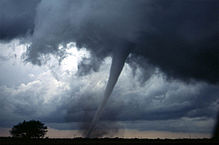Types of natural phenomena include:
Weather, fog, thunder, tornadoes; biological processes, decomposition, germination; physical processes, wave propagation, erosion; tidal flow, moonbow, blood moon and natural disasters such as electromagnetic pulses, volcanic eruptions and earthquakes.[1][2]
Physical phenomena
The act of:
Gallery
Chemical phenomena
Biological phenomena
- Metabolism
- Catabolism
- Anabolism
- Decomposition – by which organic substances are broken down into a much simpler form of matter
- Fermentation – converts sugar to acids, gases and/or alcohol.
- Growth
- Birth
- Death
- Population decrease
Gallery
Decomposition:a decaying peach over a period of six days. Each frame is approximately 12 hours apart, as the fruit shrivels and becomes covered with mold.
Astronomical phenomena
Geological phenomena
Gallery
Geology: parabola-shaped lava flow illustrates Galileo's law of falling bodies, as well as blackbody radiation. The temperature can be discerned from the color of the blackbody.
Meteorological phenomena
Violent meteorological phenomena are called storms. Regular, cyclical phenomena include seasons and atmospheric circulation. climate change is often semi-regular.
Lightning strikes during the eruption of the Galunggung volcano in 1982
A tornado on May 3, 1999 in central Oklahoma
Atmospheric optical phenomena
Oceanographic
- Oceanographic phenomena include tsunamis, ocean currents and breaking waves.
gallery
Source: "Physiography for High Schools" by Albert L. Arey, Frank L. Bryant, William W. Clendenin, and William T. Morrey. 1911, USA.
See also
- Act of God
- Electrical phenomena
- Materialism
- Midnight Sun
- Black Holes
- Black Hole Sun
- Natural Environment
- Nature
- Transient lunar phenomenon
References
- ^ Missy Allen; Michel Peissel (1993). Dangerous Natural Phenomena. Chelsea House. ISBN 079101794X.
- ^ William R. Corliss (1977). Handbook of unusual natural phenomena. Sourcebook Project. ISBN 0915554011.


.jpg)







